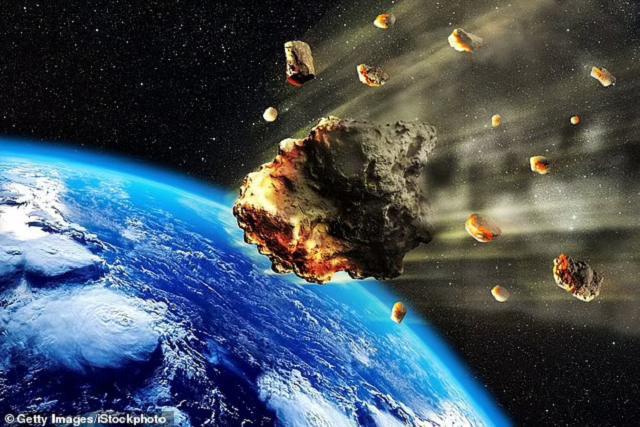Life on Earth came from an asteroid 3.8 billion years ago, NASA has proof?-Information Technology
NASA scientists, along with researchers from Japan, have found an important link between life on Earth and asteroids while studying the components of DNA and RNA, according to Hindustan Times.
According to NASA, there is always a question on the minds of scientists that, how did life on Earth begin?
This age-old question has many different assumptions and answers. One of them is the hypothesis that life on Earth may in fact come from an asteroid in space.
This hypothesis was reinforced when NASA scientists and researchers from leading Japanese universities recently found some unusual things when studying the components of DNA and RNA in space rocks. time, according to the Daily Mail.

Some scientists believe that asteroids / meteorites / space rocks “seeded” life on Earth billions of years ago. Getty/Daily Mail photo.
According to Daily Mai, our Earth was formed about 4.5 billion years ago. During its early existence, the Earth was regularly hit by meteors, comets, and other matter from space. At this time, the Earth was probably too hot to support life until about 4 billion years ago.
Although the earliest fossils discovered are marine specimens dating to about 3.5 billion years ago, scientists have found clues that lead them to believe that life on Earth seems to have been discovered. formed 3.8 billion years ago.
Some scientists think that the possibility that life based on DNA evolved early on Earth is because we had “a helping hand” from space.
Supporters of this theory are called “Panspermia” and they believe that “life” was “seeded” to Earth by meteorites “traveling” from planet to planet, or by stars. broom or dust brought by space.
According to the above hypothesis, life on Earth did in fact originate elsewhere in the universe and predates Earth’s formation.
Life “seeded” to Earth by meteorites could be early life on Mars, as a growing number of scientists believe Mars may have been more habitable than Earth in its infancy.
However, the hypothesis that life was seeded on Earth by a meteorite has encountered one major obstacle: Previously, scientists found only two of the four main components of DNA in space rocks. A key ingredient – found in RNA – was also undetectable in the space rock.
But a recent study by Japanese scientists, working at Hokkaido and Kyushu universities, and NASA scientists discovered something unusual.
In the past, scientists examining meteorites would use strong acids and heat to extract DNA components (called nucleobases). However, the team led by chemist-astrophysicist Yasuhiro Oba used more sensitive techniques with the ultra-high resolution instrument.
Accordingly, after performing a new more thorough analysis of meteorites that have landed in the US, Canada and Australia, Japanese scientists say, billions of years ago, giant space rocks – just happened to contain the basic building blocks of DNA – landed on Earth (then, completely devoid of life).
Their study shows that there are actually small amounts of previously undetected nucleobases – called pyrimidines – in space rocks.
The Japanese researchers concluded that pyrimidines may have previously evaded detection because they have a more sophisticated structure than other nucleobases.
The Japanese team examined material from three meteorites – one that fell to Earth in 1950 near the town of Murray in the US state of Kentucky, a second that fell in 1969 near the town of Murchison in Victoria, Australia, and the third fell near Lake Tagish in British Columbia, Canada.
The 220lb Murchison meteorite was recently identified as containing the oldest material on Earth – seven billion years old stardust rock.
All three meteorites are classified as space rocks that formed early in the history of the Solar System. They are rich in carbon and carbon is the main component of organisms on Earth.
“The presence of five major nucleobases in meteorites may have contributed to the emergence of genetic functions (DNA) even before life arose on Earth. The sheer abundance of nucleobases has Extraterrestrial origin may be enough for further chemical reactions on the early Earth to form life,” said Yasuhiro Oba.
Danny Glavin of NASA’s Goddard Space Flight Center and a co-author of the study also stressed that their study “definitely adds to the list of chemical compounds present on Earth before they were found on Earth.” life appeared”.
Several other scientists were also excited by the discovery.
“This is one of the last ingredients on the list where we need to prove that they were created in space,” commented Professor Mark Sephton, an astronomer at Imperial College London.
“We are very fortunate to have these very old specimens – specimens that bring us a door to conditions and events billions of years ago,” added Mr Sephton.
According to the Daily Mail, the new study certainly strengthens the theory that life on Earth may have come from an asteroid in space.
Supporters of this hypothesis are hoping that they will have stronger evidence when they can test samples taken from two large asteroids – Ryugu and Bennu – with spacecraft developed by NASA and the US Space Agency. Japan’s space agency, JAXA.
at Blogtuan.info – Source: 24h.com.vn – Read the original article here



